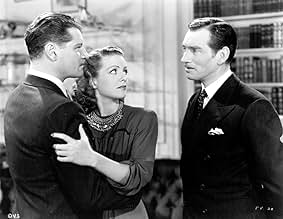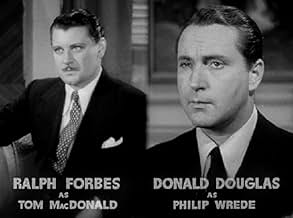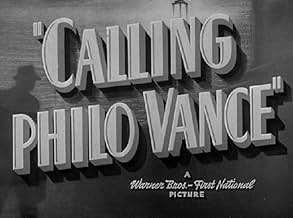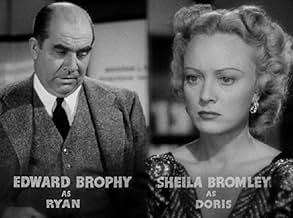Despite an exclusive contract with the U.S. government, designer Archer Coe's design is being bid on by German, Japanese, and Italian agents - until he's murdered.Despite an exclusive contract with the U.S. government, designer Archer Coe's design is being bid on by German, Japanese, and Italian agents - until he's murdered.Despite an exclusive contract with the U.S. government, designer Archer Coe's design is being bid on by German, Japanese, and Italian agents - until he's murdered.
- Director
- Writers
- Stars
Jimmy Conlin
- Dr. Doremus - Coroner
- (as Jimmy Conlon)
Wedgwood Nowell
- Brisbane Coe
- (as Wedgewood Nowell)
Herbert Anderson
- First Reporter
- (uncredited)
Henry Blair
- Hans Snauble
- (uncredited)
Egon Brecher
- Austrian Judge
- (uncredited)
- Director
- Writers
- All cast & crew
- Production, box office & more at IMDbPro
Featured reviews
The Philo Vance murder mystery series was entertaining and worthwhile but had one serious problem, the actor playing the lead role of Philo Vance kept changing from movie to movie. This was not true of other successful series such as Basil Rathbone's Sherlock Holmes and Chester Morris' Boston Blackie. By far the most competent actor in the role was the indomitable William Powell, who starred in not only the best one of the Philo Vance films but a movie classic "The Kennel Murder Case." Alas, he was too good and went on to bigger and better roles, in particular the Thin Man series. What we get with "Calling Philo Vance" is James Stephenson, who makes a pleasant enough Philo Vance but he is certainly no William Powell. On the other hand, the supporting cast is equal to and sometimes even better than the supporting cast in "The Kennel Murder Case." "Calling Philo Vance" is a reworking of the "Kennel Murder Case," updating the story to involve espionage (Hitler invaded Poland the year before this movie was released). Other than the spy angle and having Philo a government agent rather than a P.I. there is not much change. The story still involves the intriguing idea of having a murder committed in a sealed and locked room. A few of the scenes are shot verbatim from the original. So why watch this one if you can get hold of the original, which is a superior film? I'm a Philo Vance fan. So I enjoyed this one too.
James Stephenson is Philo Vance in this movie. He's in Vienna, tracking down a rumor that Richard Kipling has been selling his military airplane designs to foreign governments, instead o the US, as he is required by contract to do so. Vance gets the plans, but they are taken from him by the local police. As a result, when he returns to the States, he reports to Henry O'Neill that he has no proof that would stand up in court. Stephenson and O'Neill go to Kipling's home, only to discover him dead bebehind a locked door. He seems to have committed suicide -- by shooting himself with a bow, a gun, and a blunt instrument.
It's a remake of The Kennel Murder Case, and Stephenson's posh British accent and unhurried motions fit the character pretty well. The updating of the maguffin from Chinese art to airplane plans shows where Warner Brothers' thoughts were about the international situation. With a plethora of suspects, including Margot Stevenson, Sheila Bromley, Ralph Forbes, and Bo Ling, it's a pretty good updating of S. S. Van Dine's mystery.
It's a remake of The Kennel Murder Case, and Stephenson's posh British accent and unhurried motions fit the character pretty well. The updating of the maguffin from Chinese art to airplane plans shows where Warner Brothers' thoughts were about the international situation. With a plethora of suspects, including Margot Stevenson, Sheila Bromley, Ralph Forbes, and Bo Ling, it's a pretty good updating of S. S. Van Dine's mystery.
The main problem with this movie is that it is a remake of the 1933 the Kennel Murder Case, starring the incomparable William Powell. James Stephenson makes a passable attempt at playing Philo Vance, but without Powell's panache and humor. He would have made a better Bulldog Drummond. The plot is updated to Nazis and aviation secrets with a mysterious suicide? Murder? In the obligatory locked room. The supporting cast is as effective as most B movies, although Margot Stevenson lacks the fire and spirit of Mary Astor, who originated the role. It remains a moderately diverting movie. Be sure to catch William Hopper and George Reeves in early uncredited roles.
This is a very cheaply made and predictable programmer--predictable since its plot is taken, almost verbatim, from two earlier films. It was literally like splicing two old movie together to make a new film!
The first 15 minutes of the film is lifted right out of PRIVATE DETECTIVE 62 (1933--starring William Powell), though the hero was stealing information from a French safe in the original film and in CALLING PHILO VANCE it involved stealing from an Austrian one. In both, he was working for the state department (though they denied this) and in both cases he was deported back to the US--only to have the boat's captain be told to return the man just as they are pulling into New York harbor--at which point the man jumps overboard and the rest of the film begins. It's so exact that they are practically the same film in the first reel.
Following this narrow escape, the plot is THE KENNEL MURDER CASE (also starring Powell). I am sure of this because I just saw both 1930s films in the last month. In fact, in many places it was word-for-word the same--so much so that I couldn't stand watching the film again--especially because James Stevenson on his best day doesn't even come close to the charm and style of William Powell's version of Philo Vance. It's like having Lee Majors play the lead in High Noon instead of Gary Cooper (this DID happen) or Timothy Dalton play "Rhett Butler" instead of Clark Gable (this, sadly, also DID happen)!! So, unless you've never seen the near-perfect KENNEL MURDER CASE (which earned a well-deserved 9 from me), don't even bother with this by-the-numbers re-make. It just isn't worth your time. And, for that matter, PRIVATE DETECTIVE 62 is also quite superior to CALLING PHILO VANCE. In fact, just WHO is this James Stevenson and why is he stealing from William Powell?!
The first 15 minutes of the film is lifted right out of PRIVATE DETECTIVE 62 (1933--starring William Powell), though the hero was stealing information from a French safe in the original film and in CALLING PHILO VANCE it involved stealing from an Austrian one. In both, he was working for the state department (though they denied this) and in both cases he was deported back to the US--only to have the boat's captain be told to return the man just as they are pulling into New York harbor--at which point the man jumps overboard and the rest of the film begins. It's so exact that they are practically the same film in the first reel.
Following this narrow escape, the plot is THE KENNEL MURDER CASE (also starring Powell). I am sure of this because I just saw both 1930s films in the last month. In fact, in many places it was word-for-word the same--so much so that I couldn't stand watching the film again--especially because James Stevenson on his best day doesn't even come close to the charm and style of William Powell's version of Philo Vance. It's like having Lee Majors play the lead in High Noon instead of Gary Cooper (this DID happen) or Timothy Dalton play "Rhett Butler" instead of Clark Gable (this, sadly, also DID happen)!! So, unless you've never seen the near-perfect KENNEL MURDER CASE (which earned a well-deserved 9 from me), don't even bother with this by-the-numbers re-make. It just isn't worth your time. And, for that matter, PRIVATE DETECTIVE 62 is also quite superior to CALLING PHILO VANCE. In fact, just WHO is this James Stevenson and why is he stealing from William Powell?!
Warner Brothers probably of all the studios loved remaking its films. I guess Jack Warner thought it saved on buying new properties. Calling Philo Vance after a brief prologue updating the story to have Vance working for the State Department investigating the theft of airplane designs, it becomes almost a word for word remake of The Kennel Murder Case. Even the character names remain the same. Whole bits of dialog from the original are reused in this one.
Too bad they couldn't have gotten William Powell as well. But he was over at MGM keeping Nora and Asta in line. So James Stephenson became the latest in a long line of Vances. Philo Vance would soon fade from the screen.
Stephenson is serviceable, but lacks Powell's unique debonair charm. And of course we've seen it all before.
Too bad they couldn't have gotten William Powell as well. But he was over at MGM keeping Nora and Asta in line. So James Stephenson became the latest in a long line of Vances. Philo Vance would soon fade from the screen.
Stephenson is serviceable, but lacks Powell's unique debonair charm. And of course we've seen it all before.
Did you know
- TriviaAll the scenes involving the two murdered men are taken directly from the earlier mystery called Meurtre au chenil (1933), in which William Powell played Philo Vance. In both movies, most of the dialog in the scenes pertaining to the murders and the investigation is exactly the same, word-for-word, which clearly indicates that the script from the 1933 film was adapted to the story for this film, which focuses on the theft of secret aircraft plans. However, in "The Kennel Murder Case", the plot concerns stolen Chinese art objects.
- GoofsRalph Forbes is credited onscreen as "Tom MacDonald," but throughout the film, he is called Taylor MacDonald.
- Quotes
Dr. Doremus - Coroner: [about the dead Archer Coe] There couldn't have been much of a struggle. His hair isn't even mussed.
Ryan: [Sardonically] Somebody must have blackjacked him and then combed his hair.
- ConnectionsEdited from Private Detective 62 (1933)
- SoundtracksI'm Happy About the Whole Thing
(uncredited)
Music by Harry Warren
Played when Vance and Ryan meet Grassi in the bar
Details
- Runtime
- 1h 2m(62 min)
- Color
- Sound mix
- Aspect ratio
- 1.37 : 1
Contribute to this page
Suggest an edit or add missing content






































